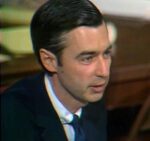If you think of an authoritarian despot, you are probably picturing some decisive, charismatic and ruthless leader. Someone who addresses the masses in a commanding, booming voice, basking in the glow of a cult of personality.
Today’s protagonist does not fill that description, not at all.
He remained a background character, a fence-sitter, for much of his life. And even when he rose to power, he never projected a menacing aura. In fact, he wished to be remembered as ‘The Smiling General’.
But don’t let that unassuming smile fool you.
Mr. Suharto was a cunning and manipulative ruler, capable of swift, violent action when times called for it.
This is the story of how Suharto rose to power in Indonesia, during one of the worst massacres of the 20th Century – and how he maintained power, while bleeding the country dry.
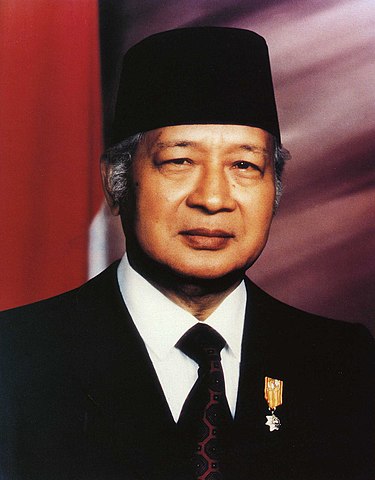
The Future President’s New Clothes
Suharto was born on the 8th of June, 1921 in Kemusu Argamulja, near Yogyakarta. This is in the island of Java, modern day Indonesia, but at that time it was part of the Dutch East Indies. He was named just ‘Suharto’, without a family name, as it is common for many Indonesians.
Regarding his family, well, there is not much we can say with certainty. According to the man himself, his parents were poor peasants. Rumors speculated that he was the illegitimate son of a Chinese businessman, while sources close to military intelligence claimed that his parents were of aristocratic stock.
More realistically, his father may have been a village irrigation official. So, not a poor peasant, but surely not an aristocrat.
Regardless of his origins, Suharto’s family could not splash the cash. In fact, he once had to drop out of a school because he could not afford the required uniform.
The young Suharto had more clothing malfunctions after graduating high school. He had secured a job as a bank clerk, but after his suit got torn in a bicycle accident … he had to quit the job! There was one employer which could provide the right attire at any time: the military.
As a means to elevate his social standing, Suharto joined the Dutch colonial forces. When the Imperial Japanese Army invaded Indonesia in 1942, the young soldier promptly switched uniforms: he joined a Japanese-sponsored militia, where he trained as an officer.
Sure, the Japanese were invaders, but they were not as hated as the retreating Dutch colonial overlords!
In fact, when the Japanese surrendered in August of 1945, Suharto joined the newly formed Indonesian army, fighting for independence against the returning Dutch occupation forces. This new force was led by Generals Achmed Sukarno and Muhammad Hatta.
Inspired by a nationalist and anti-colonialist ideology, the two officers also relied on the support of communist and Islamic factions. The fragile balance between these three forces – nationalism, communism, religion – would be a staple of Indonesian politics for the years to come.
The Making of a General
Let’s get back to the fight for independence.
Dutch forces had landed in Sumatra and Java, making considerable territorial gains. The Indonesian forces were armed with equipment left over by the Japanese, but the lack of heavy weaponry meant that they had to resort to guerrilla tactics.
The newly formed army also lacked trained officers – which may explain why Suharto was promoted to the rank of Lieutenant-Colonel at the young age of 24! And he was in for more promotions: in 1948, Suharto was given command of a brigade stationed around Yogyakarta.
He had the chance to prove his worth on the 19th of December, when Dutch forces attacked by surprise. Well, he couldn’t really prove much, as his entire brigade happened to be outside of the city! The Dutch captured Yogyakarta without firing a shot, a serious setback for anti-colonial forces.
In March of 1949, Suharto led a counterattack to retake the lost positions. This action was later immortalized in the epic 1979 film ‘Janur Kuning’ … but in reality, there wasn’t much to be epic about. The attack was repulsed after 6 hours and did little damage to the enemy!
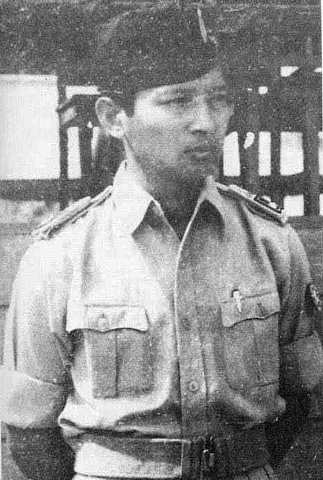
Nonetheless, the struggle for freedom had continued with more success elsewhere.
By 1949, the anti-guerrilla campaign was proving too costly to the Dutch government. Moreover, the international community did not support this colonial cause. Devastated by the German occupation in WWII, the Netherlands badly needed financial aid from the US – which came at a condition: leave Indonesia alone!
In December of 1949, the Republic of Indonesia was granted independence, with Sukarno as President and Hatta as Prime Minister.
Suharto had received a further promotion to Colonel. Over the following years, he remained in the background as an unremarkable figure which nonetheless rose steadily through the ranks.
In 1959, he was appointed Major General, in command of the Central Java military district.
This appointment was short-lived though, as his superiors removed him on allegations of accepting bribes. And yet, he managed to regain his position shortly afterwards and continue with his career.
By 1963, the General had become the head of the Army Strategic Command, a rapid reaction force based in the capital city, Jakarta, tasked with responding to national emergencies.
It was a prestigious posting, but Suharto could do better.
And he did: two years later the ambitious officer reported directly to General Yani, the Commander in Chief of the Army. Whenever Yani was traveling, ill, or otherwise incapacitated, Suharto would take his role in the interim.
It all seemed set for Suharto to take over during an emergency … one that would soon come along.
Fence-Sitting
Before we get there, let me give you some background on how tensions were building in the country. In 1959, President Sukarno implemented an authoritarian system called ‘Guided Democracy’, which allowed him to exert large influence over the parliament.
His agenda during Guided Democracy was based on three points: First, a shift towards socialist and populist reforms, as a continuation of the anti-Dutch revolution. Second, a strong anti-colonialist stance in foreign affairs matters.
Third, economic self-reliance and nationalization of foreign assets.
However, poor implementation of agricultural reforms and economic policies resulted in low production levels combined with inflation. Which in turn contributed to social unrest, and the growing popularity of the PKI – the Indonesian Communist Party.
By 1965, the PKI claimed to have 3.5 million members. It could also rely on 23.5 million members in affiliated organizations: trade unions and youth movements, for example. This made the PKI the largest communist party outside of the USSR and China.
While many officers supported the PKI, the Army saw its growing popularity with suspicion, fearing a communist takeover of the country. They started to meet with religious leaders, forging a preemptive alliance.
Amidst the backroom maneuvering, Suharto sat firmly on the fence.
Then, in the latter half of 1965, rumors reached Sukarno’s inner circle that a group of leftist officers were planning a coup.
In the early hours of October the 1st, 1965, things came to a head. An armed group called the 30 September Movement kidnapped six of the highest ranking Generals and one Lieutenant. The seven officers were then executed and dumped into a well in East Jakarta. This violent action caused the death of an eighth, innocent victim: the six-year old daughter of General Nasution.
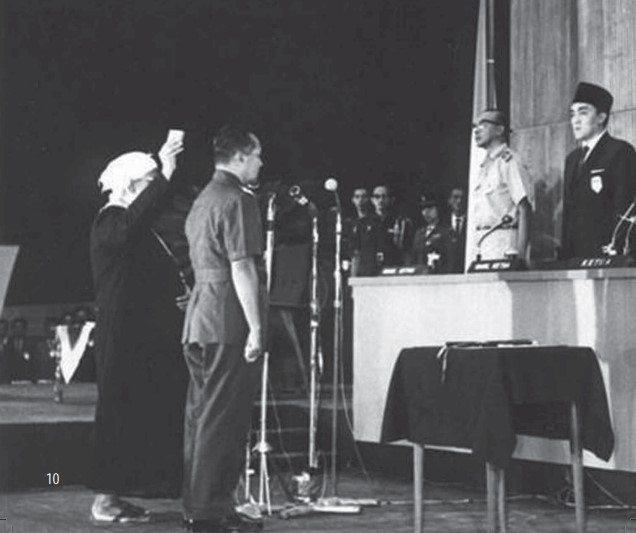
The Movement’s leader, Lieutenant-Colonel Untung of the Presidential Guard, ordered the seizure of the state broadcasting service. From there, the insurgents proclaimed a new revolutionary government.
But who was behind this coup?
According to Prof John Roosa, from the University of British Columbia, some top leaders of the PKI had played a role in the plot, but most party cadres were unaware of the plans.
The PKI’s youth organization had also been trained for military action, but were left on stand-by without orders. And they had no idea they would go after the Army!
Roosa also noted how two of the conspirators were good friends of Suharto. One of them, Colonel Latief, later declared in court that Suharto was aware of their plot to kill the officers. All in all, at least part of the PKI was behind the plot, Suharto was aware of it, but did nothing to prevent it.
It was only few hours after the assassinations that Suharto finally decided to jump off his fence and take advantage of his emergency powers.
Years of Living Dangerously
One of the murdered officers was General Yani. With him gone, Suharto was formally in command of the army!
He quickly stepped into the fray, swiftly repressing the 30 September Movement and controlling the narrative of the events. He and other top officers inflamed public opinion against the PKI, squarely blaming the assassinations and the attempted coup on the entire organization and its supporters. And according to documents declassified by the US Government, the CIA supported Suharto in his propaganda efforts by supplying communications equipment.
But despite the propaganda and pressure from the Generals, Sukarno refused to ban the PKI. This was all the motivation that Suharto needed to initiate a violent purge against the party. His first action was to dispatch the RPKAD – the Paratrooper Commando units – to Central Java and Bali. Here, communist party leaders, party members or just suspected sympathizers were rounded up and slain in mass.
The massacres soon spread throughout the entire archipelago.
Often the killings were perpetrated directly by the regular armed forces. They were mostly busy in purging those units who had sided with the KPI: The Presidential guard, two divisions in Central Java, and much of the Air Force.
When it came to civilians, the military preferred to arm and train militia units, and allow the militias to carry out ‘the dirty work’.
These militias were recruited mainly amongst the ‘Ansor’, the youth wing of the Islamic organization Nahdlatul Ulama, or NU.
The NU was already anti-communist, but to further motivate them, army officers circulated the news that PKI activists held ‘hit-lists’ of Islamic leaders. From the perspective of the Ansor, it was a case of ‘kill or be killed’.
The Ansor was not alone: the army mobilized and armed members of the Catholic and Nationalist Parties.
Most of these militias operated in rural areas. An armed band would target a village suspected of supporting the PKI. They would surround it, seize party members and sympathizers, and detain them in temporary detention centers where prisoners were tortured and interrogated.
What happened next is best described by a chilling declassified cable, sent by Edward E. Masters, Political Affairs Counselor at the US Embassy in Jakarta.
On the 30th of November, 1965, he wrote: “ … repression of the PKI continued, with the main problem that of what to feed and where to house the prisoners. Many provinces appear to be successfully meeting this problem by executing their PKI prisoners, or by killing them before they are captured.”
Prisoners were marched into the forests for the final act. They were shot, stabbed, beaten to death, and their bodies dumped into mass graves.
In many cases, bodies were thrown into rivers or left to rot in the streets. To further terrorize local populations, militias took to mutilating corpses and leaving their heads and genitals in full view.
Three Marches to Power
The purges continued well into 1966.
While no documents have proven that Suharto directly ordered the killings, he was at the top of the chain of command and directed the actions of the Paratroopers, and the training of the militias. Prof Roosa guesses that Suharto must have least approved of the massacres.
And according to Prof Brad Simpson, University of Connecticut, the extermination of the PKI propelled his career even further.
Sukarno, far from doing anything concrete to stop the bloodshed, confirmed Suharto’s status as commander-in-chief.
And on the 11th of March 1966, the President signed the ‘Supersemar’ decree, which bestowed Suharto with full powers to guarantee security, calm and stability in the country.
The general interpreted this decree to his advantage, arresting 15 ministers and dismissing the rest of the cabinet.
By the 12th of March, Suharto was the de facto head of the Indonesian government, with Sukarno still in place as nominal president. In March of 1967, the People’s Consultative Assembly appointed Suharto acting President.
The consolidation of his power became complete exactly one year later. In March of 1968, the Assembly elected Suharto as President with full powers, for the first of many five-year terms.
The low-profile General, until now a power in the shadows had risen to power, sailing unscathed amidst a tempest of bloodshed he and his circle of officers had instigated.
It is still difficult to estimate the toll that this purge exacted on the Indonesian people, due to lack of reliable records. Estimates of mass murders range from 100,000 to 2 million victims.
Historian Robert Cribb suggests that half a million dead could be an accurate figure.
In addition to those slain, almost three quarter million Indonesians were imprisoned, with sentences ranging from one to thirty years. Many high-ranking members of the PKI were sentenced to death, while most members were sentenced to hard labor. Members of the Gerwani, the Movement of Conscious Indonesian Women, were also subjected to sexual abuse and rape while in jail.
Indonesia’s New Order
In March 1966, Suharto began implementing a series of policies which he called ‘Orde Baru’ – or New Order.
The first policy shift was to ‘de-politicize’ Indonesian society.
Suharto created a system by which citizens were organized in hundreds of functional groups: one for peasants, one for civil servants, one for business owners, and so on. This tactic was designed to prevent the formation of trade unions and ensured capillary control of the population.
These groups were coordinated by the organization Golongan Karya – or GolKar for short, which became the predominant political party. Suharto also ensured that the military fulfilled a dual function, both as a defense organization and a political force – becoming the actual rulers of the country.
Then, Suharto restored ties with the West and put an end to a costly military confrontation with Malaysia, initiated by Sukarno in January of 1963.
Finally, Suharto realized that a stable rule required improved living standards for Indonesians. To boost the economy, he did a U-turn on Sukarno’s policies. No more talk of self-reliance or nationalization: the new ruler welcomed with open arms foreign investments, especially in the oil sector.
And if ungrateful oil workers dared to form unions and kick up a stink … no problem: Suharto’s soldiers would intervene to preserve a harmonious working environment!
Another pillar of Suharto’s stability was the massive growth of the public sector. By the early 1970s, about 1.5 million Indonesians were employed by the state. The number tripled over the next three decades.
Civil servants not only enjoyed a steady salary. They were also provided a chance to boost revenue with some bribery on the side. This system guaranteed Suharto and GolKar a steady base of voters at every election.
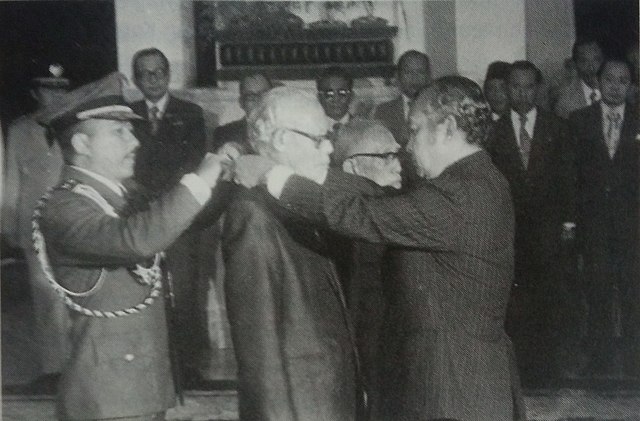
In the late 1970s, Suharto also sought to build a more benevolent image for himself to the outside world, who largely saw him as a despot.
As he opened the country to foreign investment, he had to bow to certain international pressure, at least partially.
Could he dial down the authoritarianism? Just a tad?
He did, by releasing tens of thousands of political prisoners. But this is not to say that the ‘smiling general’ renounced his old ways.
The army was always ready to react with swift brutality against real or perceived threats. Especially against those movements who threatened the integrity of the nation.
For example, the local population in Papua was kept in a state of constant, violent counterinsurgency by the armed forces, from the late 1960s to 1998.
Yet, during the late 1960s and early 1970s, Indonesia under Suharto’s New Order appeared like a success story.
Deep Pockets
Suharto’s rule was definitely authoritarian, yet he was clever enough to always operate within constitutional boundaries. The new president had successfully restored order to the country – although we may argue that he and his faction were largely responsible for the initial state of disorder!
Indonesia had also become a key player in the game of chess that was the Cold War. Before Sukarno could drift towards the Communist bloc, Suharto had yanked the country into the opposite direction. Under his authority, Jakarta became one of the founding members of the Association of Southeast Asian Nations, or ASEAN – the equivalent of NATO for the region.
But his greatest achievement was to restore economic growth. Under the New Order, every year the local economy grew 6.6% on average. Living standards improved in general, although the public sector, the military, and urban elites benefited more than other classes.
This growth was driven by foreign investments and especially by the mass export of Indonesia’s vast natural resources, mainly oil and timber.
Revenues from these sales were reinvested by the government into the expansion of urban and suburban areas, as well as literacy programs and family-planning initiatives.
But this expansion had a rotten core. Suharto and his cabinets failed to reinvest into the development of state infrastructure and into a local manufacturing sector. Worse than that, much of the income from oil and timber disappeared into the deep pockets of Suharto, his allies, and his six children.
An example of this mismanagement is the state-owned oil company, Pertamina. Compared to the Malaysian equivalent Petronas, this company had access to much larger oil reserves. And yet it consistently under-performed compared to its neighbor.
In theory, Pertamina could have been a cash cow. In practice, it was milked only by Suharto’s family.
Stick and Carrot
Cracks in the international facade began to form in the mid-1970s.
Most of the population was fed up with the corruption, collusion, and nepotism rampant in Suharto’s circle. Students were especially disillusioned with the inflow of foreign investments, and how they were funneled into Suharto’s wallet.
On the 15th of January 1974, Japanese Prime Minister Kakuei Tanaka was in Jakarta for an official visit. It was the perfect occasion for thousands of students to stage massive protests, and thus embarrass the authoritarian leader. The protests degenerated into 12 hours of riots, with fires blazing throughout Jakarta.
These became known as the ‘Malari riots’. Suharto reacted with a signature mix of stick and carrot.
First, he had twelve newspapers shut down and its journalists imprisoned without trial. The remaining publications began applying a form of self-censorship, which effectively curbed any dissenting voice. But then, he complied with some of the protestors’ requests. The government enacted restrictive measures on foreign investments, favoring the development of local businesses.
The next crisis took place in November of 1975.
The eastern half of the Island of Timor, until then a Portuguese colony, declared independence.
The independent East Timor was led by the left-leaning party Tefilin – and Suharto could not tolerate a communist threat on his borders.
In December, the army invaded, annexing East Timor as the 27th province of Indonesia. The international community protested the invasion, and the UN did not recognize the annexation. But in practical terms, Suharto’s troops were free to garrison the territory – and even freer to carry out a brutal campaign of repression, which claimed up to 200,000 lives.
Downfall
Suharto’s international star shone again briefly in the following decade.
In 1985, he traveled to Rome for an award ceremony. At the headquarters for the Food and Agricultural Organization, the FAO, he was celebrated for having raised rice production in Indonesia.
The country was now self-sufficient in that respect and didn’t need to import rice any longer. But that was a temporary triumph. Sure, crops had been growing from 1977 to 1982, but they started to decline soon afterwards. Since then, the government had in fact encouraged the conversion of rice paddies into suburban development projects.
By the early 1990s, Indonesians were back to importing large shipments of rice.
Mismanagement and corruption had created a paradoxical situation.
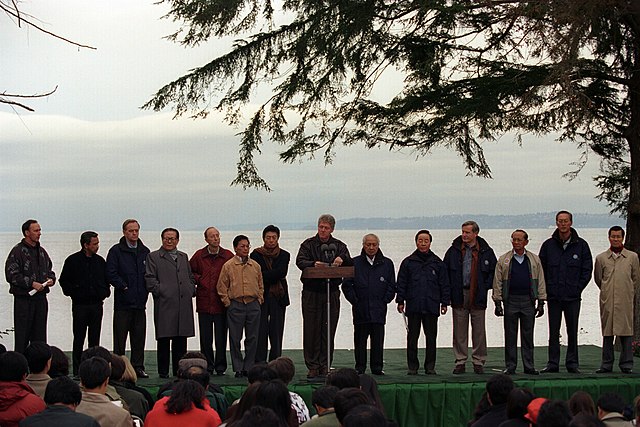
Indonesia had all the fertile land and agricultural labor required to feed its growing population – in theory. In practice, arable land was destined for other purposes and hundreds of thousands of farmers were forced to migrate, seeking employment in neighboring countries.
The regime had thus alienated any remnant of support by the rural masses.
Next in line were the backbone of GolKar supporters, middle-class civil servants and small business owners. Until then, the mirage of continued growth had kept them at bay, and silenced any voice rising against the bad habit of pocketing kickbacks.
In 1997, however, Indonesia became one of the main victims of a currency crisis which devastated the economies of Southeast Asia.
The country faced every economist’s worst nightmare: stagflation – a lethal mix of recession and soaring inflation.
Suharto resisted demands for structural reforms, while living standards rapidly collapsed nationwide.
A mass movement for “reformasi”, or institutional reform, took to the streets. Anti-government demonstrations broke out in Jakarta and other cities in May of 1998. Confronted by the security forces, protests escalated into violent riots which claimed more than one thousand victims. But now, the once ‘smiling general’ realized that he lacked the political and military backing to intensify the crackdown. On the 21st of May 1998, Suharto saw the writing on the wall and thought it best to resign.
His deputy, Bacharuddin Jusuf Habibie, became Indonesia’s third president.
CONCLUSION
Suharto left power with an apology to the nation, “I am sorry for my mistakes.”
Well, thanks, but that may not be enough. In fact, the new cabinet demanded more than just an apology. In 2000, the Government filed embezzlement charges against him: Suharto was accused of misappropriating more than $600 million. But the former despot was in ill health and the charges were dropped.
In 2007, the UN and the World Bank estimated the true extent of his pilfering: the value was estimated between 15 and 35 billion dollars (!!!). In 2007, Time magazine picked up the story, reporting that Suharto and family had stolen 15 billion. The magazine was sued for defamation, a court case which Suharto won (!) in November of that year.
In the meantime, the Indonesian government tried again to sue him for embezzlement. And in December, they also announced an investigation into six cases of human rights abuse. One of them was about the massacres of ’65-’66.
But Suharto would never face trial. On the 4th of January, 2008 the former general and president was hospitalized, due to complications of renal failure, among many other ailments. His health quickly worsened, due to internal bleeding and sepsis.
Suharto was declared dead on the 27th of January.
The then President Yudhoyono asked Indonesians to respect one of their top countrymen. Just two months earlier, that top countryman had laughed off his allegations.
“It’s all empty talk … Let them accuse me. The fact is I have never committed corruption.”
General biographies
https://www.britannica.com/biography/Suharto
https://www.nytimes.com/2008/01/28/world/asia/28suharto.html
John Roosa’s obituary of Suharto
https://www.jstor.org/stable/40376448
Indonesian Independence
http://www.historytoday.com/archive/independence-indonesia
https://www.eur.nl/sites/corporate/files/Scagliola_Silences_and_Myths2007_manuscript.pdf
Anti-communist purges
New Order
https://www.indonesia-investments.com/culture/politics/suharto-new-order/item180?
https://journals.sagepub.com/doi/abs/10.1177/097492847903500402?journalCode=iqqa
https://www.jstor.org/stable/2613527
https://library.oapen.org/bitstream/handle/20.500.12657/33621/459541.pdf?sequence=1&isAllowed=y
Malari riots
https://voi.id/en/amp/1774/the-malari-incident-of-1974-becomes-the-war-of-two-generals
East Timor
https://www.bbc.com/news/world-asia-pacific-14952883.amp
Reformation era
https://www.indonesia-investments.com/culture/politics/reformation/item181
Family
https://indonesiaatmelbourne.unimelb.edu.au/the-soeharto-family-where-are-they-now/



